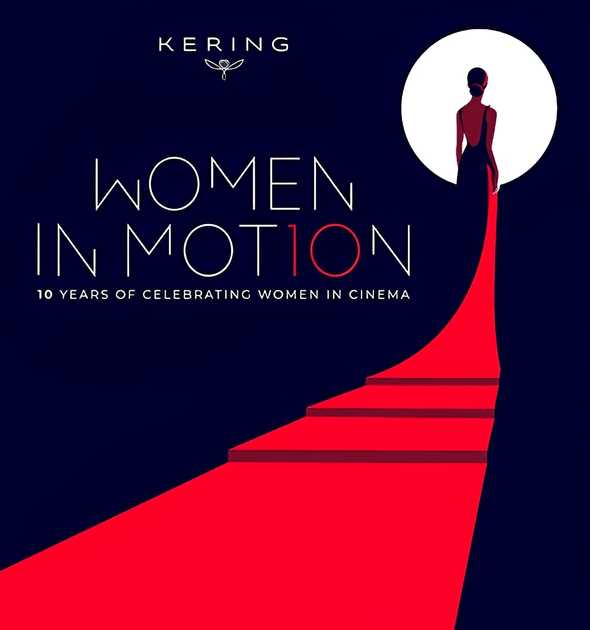Kering’s Women in Motion: A Decade of Empowerment on the Red Carpet
April 28, 2025
When Kering launched the initiative in 2015, it was more than just a celebration of women in cinema – it was a deliberate statement about rewriting the narrative of women’s roles, both in front of and behind the camera. The programme, which began with its spotlight on the Festival de Cannes, quickly became a driving force for gender equality, illuminating the pivotal contributions of women in entertainment. But beyond the statistics and figures,Women In Motion has woven a narrative that intertwines personal stories, striking fashion moments, and an unyielding push for change.
As Kering celebrates a decade of Women in Motion, the programme has tracked the evolution of gender equality in the film industry through a comprehensive study conducted by Dr. Stacy L. Smith. This study, which has been instrumental in understanding the real-world impact of initiatives like Women in Motion, provides a deep dive into the measurable shifts in both on-screen and behind-the-scenes representation since 2015. The study reveals that women in lead roles in US top-grossing films have increased from 32% in 2015 to 54% in 2024, a significant marker of progress towards parity. However, the study also underscores that there is still much work to be done, particularly for women of colour and those over 45, whose representation remains disproportionately low. These demographics have seen only marginal increases in representation.
From Underrepresented to Iconic: Women on the Red Carpet
It is impossible to discuss Women in Motion without acknowledging the red-carpet moments that have become synonymous with the programme. Each year, the world watches as leading ladies step onto the glitzy Cannes steps, not just as stars but as symbols of the evolving conversation around women’s empowerment. Figures like Cate Blanchett, Salma Hayek Pinault, and Diane Kruger have turned the festival into a runway for both advocacy and artistry, with every step they take a declaration of strength.
Blanchett, whose leadership as the jury president at Cannes in 2018 included a striking protest in the form of a march up the stairs alongside 81 other women, has become the epitome of activism on the red carpet. Her graceful advocacy continues to leave an indelible mark. At that moment, wearing a chic Armani Prive gown, Blanchett’s powerful stride was not just a fashion statement – it was a visual declaration against the inequality women directors faced at the festival. The boldness of the gesture, paired with her iconic fashion choices, made for a moment of rare intersection between style and social change.
Similarly, Salma Hayek Pinault has used the Cannes platform to shed light on the intersection of fashion and power. Her collaborations with Women in Motion have illuminated the often-overlooked stories of women of colour in the industry. At the 2023 Cannes Film Festival, Hayek was a vision in a delicate yet fierce dress from Gucci’s latest collection, a nod to her long-standing relationship with the house. Her elegance on the carpet wasn’t just about the gown – it was a direct reflection of the grace with which she has navigated the industry’s power structures, constantly pushing for more visibility and opportunities for women of colour both on-screen and behind the camera.
Behind the Camera: Women Who Create and Inspire
While Women in Motion has undeniably been about showcasing the glamour of female talent on-screen, it’s equally devoted to amplifying the voices of women who work tirelessly behind the camera. The rise of women directors, long overshadowed by their male counterparts, has been one of the most powerful narratives to come out of the programme. While on-screen progress has been substantial, it’s the rise of women behind the camera that marks one of the most significant victories in the last decade. In 2015, women directed a mere 7.5% of the top-grossing films in the U.S. By 2024, that figure had more than doubled to 13.6%.
One of the most inspiring stories is that of Chloé Zhao, whose directorial triumph Nomadland made her the first woman of colour to win the Academy Award for Best Director. Zhao’s appearance at the Cannes Film Festival was a mixture of poise and quiet strength, with her minimalistic yet elegant fashion choices underscoring her commitment to authenticity. Her presence on the red carpet wasn’t just about showcasing a beautiful ensemble – it was a reflection of her work’s ethos, grounded in the real stories of those often left out of mainstream narratives.
Similarly, Jane Campion’s impact, both in fashion and filmmaking, cannot be overstated. The first woman to win the Palme d’Or twice, Campion’s understated style at Cannes has always mirrored her approach to filmmaking – quiet, deliberate, and full of substance. Her 2022 appearance at Cannes was a lesson in refined sophistication, where her classic black dress was complemented by the deep meaning of her film The Power of the Dog. Campion, much like her fashion choices, has never been loud for the sake of attention, but her influence and power resonate through the quiet strength of her storytelling.
The Impact of Fashion and Advocacy: A Seamless BlendThe intersection of fashion and activism has been a hallmark of Women In Motion, particularly when it comes to the programme’s focus on women’s rights and the empowerment of female creatives. At the 2018 Cannes Film Festival, when 82 women made their iconic protest on the red carpet, it was more than just a symbolic act – it was a bold intersection of beauty, elegance, and fierce advocacy for gender parity. The women, dressed in an array of haute couture from the likes of Louis Vuitton and Chanel, used the red carpet as a platform to demand the recognition they so rightfully deserved.
The statement was clear: women are not just ornamental figures to be admired from afar but are integral players shaping the future of cinema, culture, and beyond. Fashion, with its undeniable power to influence and inspire, became the perfect medium to communicate this message.Women In Motion understood that a beautiful gown or a well-tailored tuxedo is not just about appearances; it’s about making a statement and claiming space in an industry that has historically shut out women.
A Legacy of Change: The Emerging Talent Award
As Kering’s Women in Motion initiative continues to expand its influence globally, it has become clear that the programme’s impact is not limited to Hollywood. From Europe to Australia, countries around the world have begun to prioritise gender parity, with initiatives like France’s funding bonuses for gender-balanced crews and Sweden’s 50% funding commitment for women directors making waves in global cinema.
Perhaps the most poignant moment in Women in Motion’s journey is its Emerging Talent Award, which has given a platform to up-and-coming female directors, producers, and creatives who are shaping the future of cinema. This award is more than just a nod to talent; it’s a crucial recognition of the barriers women face in securing the resources they need to tell their stories. By providing financial support and visibility,Women in Motion has helped launch the careers of female filmmakers who may have otherwise been overlooked. This support aligns with the findings in Dr. Stacy L. Smith’s study, which highlights the persistent challenge of securing financing for women filmmakers compared to their male counterparts.
One such recipient, Carla Simón, whose film Alcarràs won the Golden Bear at the Berlinale in 2022, represents the power of visibility. At Cannes, she arrived in a simple yet striking Dior gown that mirrored the authenticity and beauty of her storytelling. The award has provided not just recognition but the resources for women like Simón to continue breaking down the doors of an industry that is too often defined by a lack of opportunities for women.
Meanwhile, other prominent female directors, such as Justine Triet, who won the César Award for Best Director, continue to break barriers. Triet’sSybilwas critically acclaimed and her recognition at the César Awards symbolizes the ongoing strides women filmmakers are making in an industry traditionally dominated by men. Women In Motion continues to serve as a beacon for these filmmakers, offering not just exposure, but the crucial support necessary to push their stories forward.
Fashion, Advocacy, and the Road Ahead
As Kering’s Women in Motion celebrates its 10th anniversary, it is clear that the programme has achieved far more than just spotlighting women in cinema. It has fostered a deeper understanding of what it means to be a woman in a space traditionally dominated by men. It has shown that women can wield influence both in front of the camera and behind the scenes, shaping the very fabric of the entertainment industry.
The in-depth study presented by Kering and conducted by Dr. Stacy L. Smith has been crucial in tracking this evolution. It has shown that while progress has been made – such as the increase in women leads in major films and the rise of women directors – there is still much work to do. The industry must continue to fight for parity, particularly for women of colour and those over 40, who remain underrepresented. Kering’s Women in Motion has been at the forefront of this movement, utilising its platform to elevate women’s voices, advocate for change, and celebrate the artistry of female filmmakers. As the next decade ofWomen in Motionunfolds, we can only imagine what new heights these women will reach, breaking down barriers and building new worlds on screen. There is Hope. And Couture.


